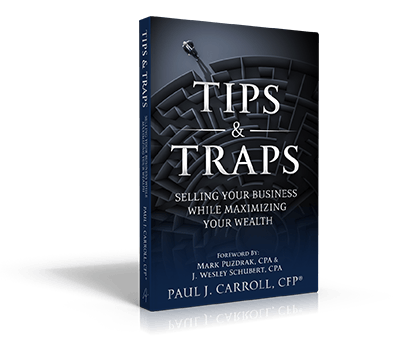 When it comes to preparing your business for sale, the journey involves much more than just putting a price tag on it; it requires meticulous preparation and strategic positioning to ensure that your business is an attractive asset to potential buyers. Beyond knowing how to sell your business, at the core of preparing is answering the fundamental question: Does the business run independent of your involvement?
When it comes to preparing your business for sale, the journey involves much more than just putting a price tag on it; it requires meticulous preparation and strategic positioning to ensure that your business is an attractive asset to potential buyers. Beyond knowing how to sell your business, at the core of preparing is answering the fundamental question: Does the business run independent of your involvement?
Can the business operate without you
 Many entrepreneurs and business owners don’t realize the difference between owning a business and owning a job. If your presence is critical for the daily operations, then you’re essentially self-employed; you own a job. This dependency often scales inversely with the business’s size. When you are the rainmaker, leader, manager, and CEO all wrapped into one, what you’re selling is limited to tangible assets, rather than a sustainable enterprise.
Many entrepreneurs and business owners don’t realize the difference between owning a business and owning a job. If your presence is critical for the daily operations, then you’re essentially self-employed; you own a job. This dependency often scales inversely with the business’s size. When you are the rainmaker, leader, manager, and CEO all wrapped into one, what you’re selling is limited to tangible assets, rather than a sustainable enterprise.
A business that can’t operate in your absence is less likely to be an attractive proposition for potential buyers, translating to a lower market value. It’s not uncommon for a startup to be highly dependent on the leader-founder. The greater the operational autonomy of a business from a few key players, the better the valuation.
How do we build operational autonomy? There are two key approaches: one is by building business processes and the other is by identifying yardsticks, or business performance KPIs, with which to measure your progress and success.
Building Business Processes
Building business processes for a company preparing for sale is about creating a system that ensures operational efficiency and continuity without the owner’s day-to-day involvement. Here are steps an owner can take now to achieve a self-managing company:
- Document Current Processes: Begin by mapping out existing workflows for all operations. Identify the steps taken from the start to finish of each core business activity. This documentation should be detailed enough that a new person could step in and understand the workflow.
- Standardize Operations: Establish standard operating procedures (SOPs) for all tasks. This reduces variability in outcomes and ensures that quality and service levels remain consistent regardless of who is performing the work.
- Automate Where Possible: Invest in technology to automate repetitive and time-consuming tasks. This not only increases efficiency but also reduces the reliance on any one person’s knowledge or skills.
- Outsource Non-Core Activities: Consider outsourcing functions that are not central to the business’s value proposition, such as payroll, IT services, or janitorial services. This allows the company to focus on its core competencies.
- Train and Cross-Train Employees: Develop a training program to ensure all employees are well-versed in their roles. Cross-training is equally important, as it ensures that there is more than one person capable of performing each role within the business.
- Implement Quality Control Measures: Develop metrics and checks to ensure that the quality of the work remains high. This could be through regular audits, customer feedback, or performance metrics.
- Develop Leadership: Identify and nurture potential leaders within the company who can take on managerial roles. This reduces dependency on the owner for decision-making and direction.
- Review and Adjust: Regularly review processes to ensure they remain relevant and efficient. Adjust as needed based on employee feedback, customer needs, and changes in the business environment.
Taking these steps early on can position a business as a self-sustaining entity, making it more attractive to potential buyers and contributing to a higher selling price. Operational efficiency signifies a lower risk for the buyer, as the business is less likely to experience disruptions during the transition of ownership.
Business Performance KPIs
Identifying business performance KPIs (Key Performance Indicators) is a critical step for a business owner preparing to sell. These KPIs not only provide a snapshot of the company’s health but also demonstrate its long-term viability and potential for growth to prospective buyers.
Here are ten ways an owner can identify the most meaningful KPIs:
1. Align KPIs with Business Goals: The KPIs should directly reflect the business’s strategic objectives. If the goal is growth, KPIs might focus on market expansion and sales increases. If the goal is efficiency, KPIs might center on cost reduction and operational throughput.
2. Industry Benchmarks: Look at standard KPIs within your industry. Different sectors have different performance metrics. For example, retail businesses might look at inventory turnover, while a SaaS company might look at monthly recurring revenue and churn rate.
3. Financial Health Indicators: Common financial KPIs include net profit margin, gross margin, EBITDA, and cash flow. These indicators are crucial for buyers, as they provide insight into the business’s profitability and financial stability.
4. Customer and Sales Metrics: Depending on the nature of the business, relevant KPIs could include customer acquisition cost, customer lifetime value, conversion rates, and retention rates. These metrics demonstrate the effectiveness of sales and marketing strategies and the potential for sustainable revenue.
5. Operational Efficiency Metrics: These might include production cycle times, employee efficiency, and quality control metrics. Operational KPIs show how well the business runs and where there may be opportunities for improvement.
6. Employee Performance and Satisfaction: Employee turnover rates, satisfaction scores, and productivity measures can indicate the company culture and operational health, which are important for buyers.
7. Consult with Experts: Wealth managers, business brokers, and other consultants can provide valuable insight into which KPIs are most important for buyers in your particular market.
8. Historical Performance Data: Analyze past performance to identify trends and patterns that could be attractive to a buyer. Demonstrating a trajectory of improvement or steady performance can be a strong selling point.
9. Use of Technology: Implement business intelligence tools or dashboards that can help track these KPIs in real-time, providing ongoing insight into the business’s performance.
10. Review and Refine: KPIs should not be static. As the business evolves, so too should the KPIs. Regularly review whether the KPIs still align with business objectives and make adjustments as necessary.
By establishing clear and measurable KPIs, business owners can not only manage their business more effectively but also build a compelling case for its value when they decide to sell. Buyers want to see evidence of a well-run business, and strong KPIs provide that evidence.
Preparing your business finances
The clarity and integrity of your financial records are non-negotiable when it comes to preparing your business for sale.
Preparing your business finances means you first need to address any inaccuracies in your accounting records which can undermine the trust of potential buyers and diminish the value of your business. It’s not uncommon to find that the financial records resemble a personal piggy bank more than a corporate ledger, which can be detrimental to your company’s valuation. Software like  QuickBooks might offer arithmetic precision, but without proper input, you risk ‘garbage in, garbage out.’ By ‘normalizing’ these records—eliminating personal expenses and investing in accurate tax payments—you enhance the business’s appeal to buyers. An external CPA and bookkeeper, preferably from different firms, are invaluable for bringing objectivity and expertise to your financials, ensuring every figure can stand up to scrutiny.
QuickBooks might offer arithmetic precision, but without proper input, you risk ‘garbage in, garbage out.’ By ‘normalizing’ these records—eliminating personal expenses and investing in accurate tax payments—you enhance the business’s appeal to buyers. An external CPA and bookkeeper, preferably from different firms, are invaluable for bringing objectivity and expertise to your financials, ensuring every figure can stand up to scrutiny.
Creating a Deal Book requires strategic financial presentation. You don’t need to constantly update every financial statement, but when due diligence calls, each document—from balance sheets to hard asset listings—must be readily accessible.
This means establishing an efficient indexing system that allows for quick retrieval and printing. Additionally, it’s imperative to reconcile the depreciated and actual values of your assets. Whether it’s a vintage airplane that’s appreciated over time or tech equipment that’s outlived its depreciation schedule, realistic valuation is key.
Beyond the numbers on paper, it’s the real-time financial health that will catch a discerning buyer’s eye. This means keeping a close watch on the movement of your assets and liabilities, understanding the implications of actions like factoring receivables, and consistently evaluating KPIs to bolster profitability. The final touch is establishing a financial dashboard, a dynamic tool that keeps you informed about the business’s pulse without your direct involvement, signifying to buyers that the business is a well-oiled machine. As you move forward, the next phase—pre-packaged due diligence along with the relevant business documentation—becomes a vital part of this financial fixing, marking one of the most critical stages in the journey toward a successful sale.
Business Documentation
In preparing to sell your business, you will need to gather or create business documentation for the potential buyer.
The Letter of Intent (LOI) stands as a pivotal document that marks the initial agreement between the buyer and seller, showcasing a genuine intention to proceed. It’s vital for sellers to discuss and establish the terms of the LOI, as it lays the groundwork for all subsequent discussions.
As part of your prepared exit strategy, you will have a complete due diligence package ready for the buyer. You will also have Non-Disclosure Agreements (NDAs), non-compete clauses, indemnity agreements, and precise agreements regarding working capital and tax liabilities. Each document plays a significant role in ensuring a transparent and secure exchange between the buying and selling parties.
Business Valuation
Going through the process of figuring out what your business is worth is not easy, especially if you’re thinking of selling what you’ve worked so hard to build. You’ll have to determine which type of business valuation method is best for your type of business, and you may need to seek out professional assistance. This step isn’t just for show; it’s a key part of figuring out how much money you can actually get when you sell your business.
It’s important for business owners to get a clear valuation early on. The benefit is twofold: you’ll know how much your business is worth right now and you’ll identify ways you can make it more valuable through operational enhancements.
Build your team
Building the team who will guide you through the preparation and sale of your business is critical. The right team can provide invaluable advice, steer you clear of costly pitfalls, and ensure that your financials and business processes are in order. They act as a bridge between you and the buyer, negotiating deals with a non-emotional, objective eye and safeguarding your interests. As you gather a team of seasoned professionals—lawyers, CPAs, and M&A specialists—your wealth manager stands out by providing a holistic view, ensuring that the sale aligns with your long-term financial goals.
How far in advance should I prepare to sell my business?
Preparing to sell your business can start right away, whether you have two or ten years until you want to sell. You’ll want to start assembling the key members of your team – your wealth manager to help you form your financial plan, an accountant to review your books, and a valuation specialist for that initial valuation – as soon as possible. This way, you have a realistic view of what your business is worth and can map out a timeframe that fits with your personal goals and the operational fixes you may need to make. From the time you decide you actively want to pursue an exit strategy, you should allow a minimum of one year from start to finish to solidify a deal.
A business ready for sale demonstrates its resilience through well-structured business processes, clear and actionable performance KPIs ,and transparent and organized finances. It also needs solid business documentation, a realistic and justified valuation, and a competent team to carry on the legacy. Each of these components plays a critical role in not just maintaining day-to-day operations, but also in reinforcing the value and potential of your business in the eyes of prospective buyers.
To learn more, request a complimentary copy of Paul Carroll’s book Tips & Traps: Selling Your Business While Maximizing Your Wealth.
Paul is the founder and CEO of Avion Wealth, LLC. He leads a team of wealth managers in building and executing financial plans for high net worth individuals and families. Contact Avion Wealth to speak with a financial advisor.





